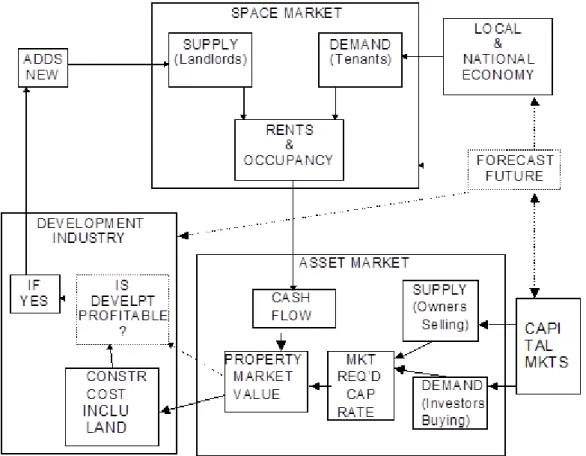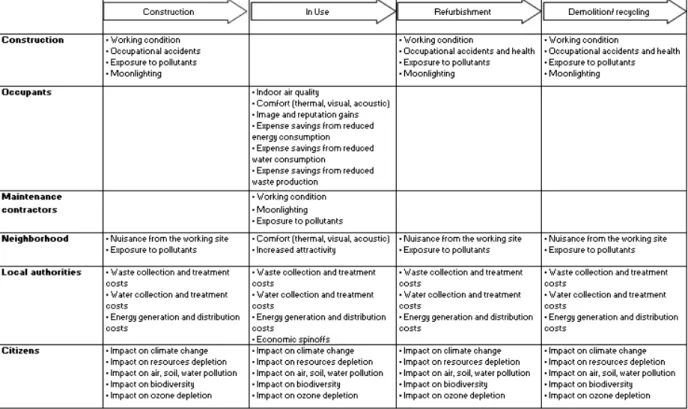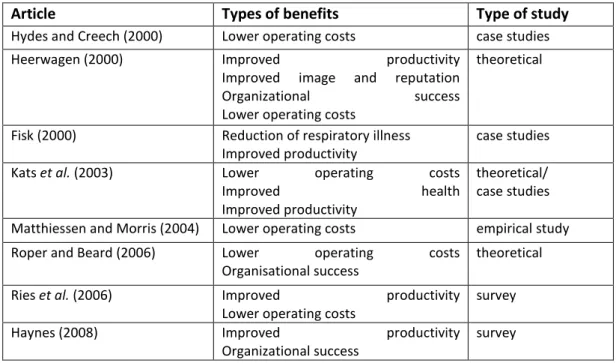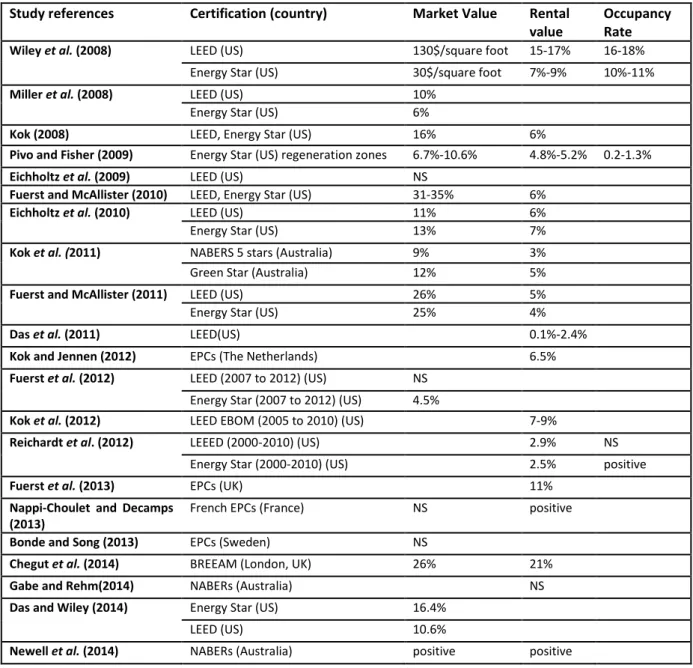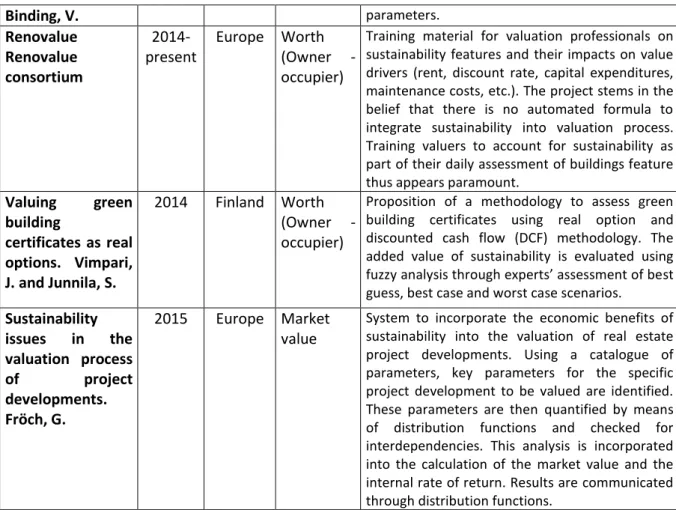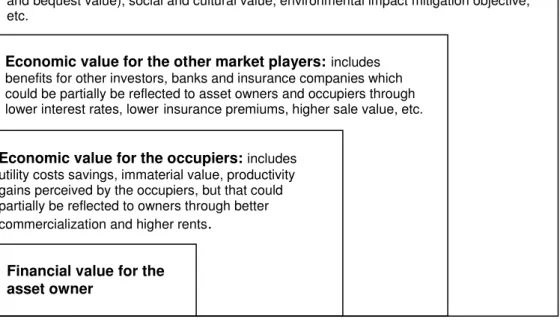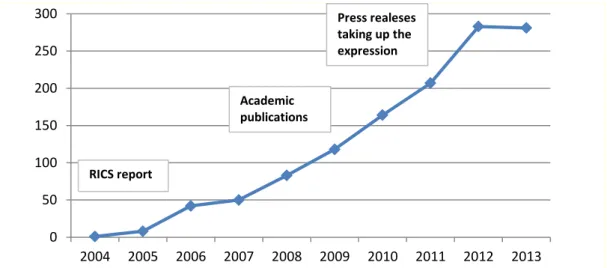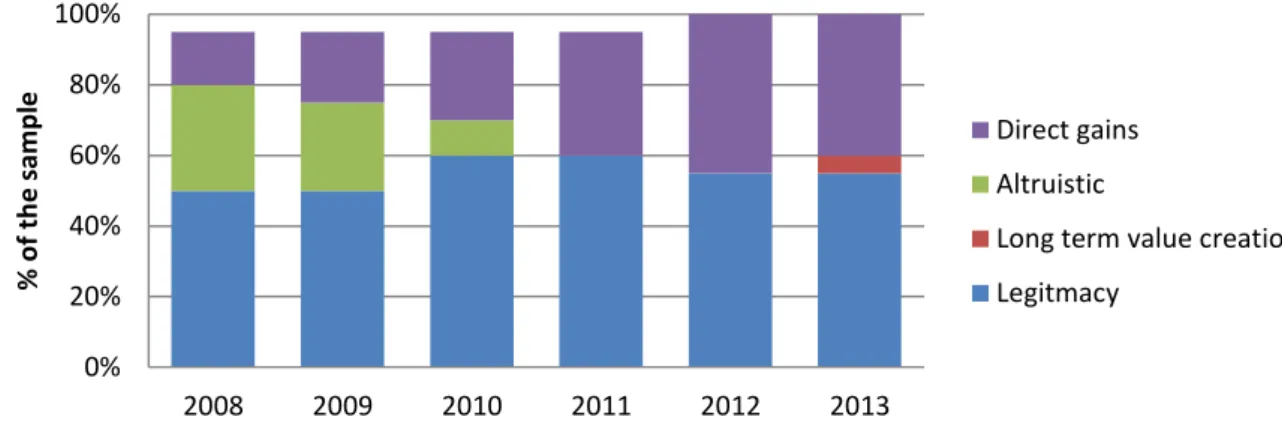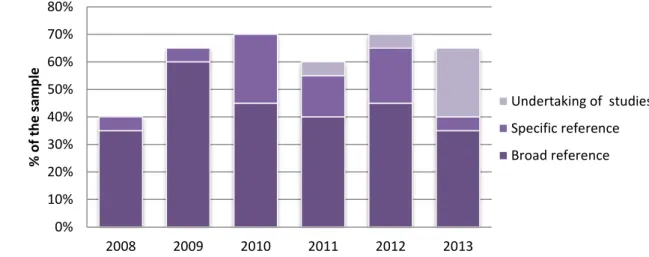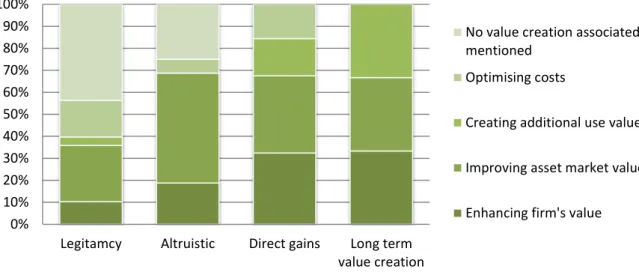ECOLE DOCTORALE DE DAUPHINE
DRM-CEREG
Valorisation des critères de durabilité des actifs immobiliers
tertiaires
THESE UNIVERSITAIRE
pour l’obtention du titre de
DOCTEUR EN SCIENCES DE GESTION
(Arrêté du 7 août 2006)présentée publiquement le 27 octobre 2015 par
Yona KAMELGARN
COMPOSITION DU JURY
Directeur de thèse: Arnaud SIMON, Maitre de conférences HDR, Université Paris-Dauphine Rapporteurs : Andrée DE SERRES, Professeure, Université du Québec à Montréal
Thomas LÜTZKENDORF, Professeur, University of Karlsruhe
Suffragants: André SOBCZAK, Professeur, Audencia Ecole de Management Dominique BLANC, Directeur de la recherche, Novethic
PARIS-DAUPHINE UNIVERSITY ECOLE DOCTORALE DE DAUPHINE
DRM-CEREG
Valorisation of sustainability-related criteria in commercial
real estate
DOCTORAL DISSERTATION
To obtain the degree of
DOCTEUR EN SCIENCES DE GESTION
(Arrêté du 7 août 2006)publicly defended on the October 27th by
Yona KAMELGARN
JURY COMPOSITION
Thesis supervisor : Arnaud SIMON, Maitre de conférences HDR, Université Paris-Dauphine Reviewer : Andrée DE SERRES, Professor, Université du Québec à Montréal
Thomas LÜTZKENDORF, Professor, University of Karlsruhe Suffragan: André SOBCZAK, Professor, Audencia School of Management
Warnings
This thesis was conducted within the framework of a French contract (CIFRE) between Paris-Dauphine University and the company Novethic.
The views expressed in this dissertation are those of the author, and do not necessarily reflect the positions of Paris-Dauphine University and Novethic.
*************************************************************
Avertissements
Cette th se a t alis e da s le ad e d u e Co e tio I dust ielle de Fo atio pa la ‘e he he CIF‘E e t e l U i e sit Pa is-Dauphine et la société Novethic.
Les opi io s e p i es da s ette th se so t elles de l auteu , et e efl tent pas nécessairement les positions de l U i e sit Pa is-Dauphine et de Novethic.
Abstract
In relations with the rising concerns on sustainable development and Corporate Social Responsibility (CSR), sustainability-related topics have become a key trend in the real estate sector. This dissertation examines sustainable real estate, and investigates more particularly the value it holds for various stakeholders. Each of the five chapters focuses on different market players to analyse how sustainability-related topics are perceived, and the extent to which these perceptions shape practices. Chapter 1 questions the notion of value associated with sustainability-related features at a building level. Chapter 2 examines the value creation strategies associated with sustainability-related topics at corporate level. Chapters 3 and 4 focus respectively on the diffusion of sustainability certification schemes, a d o upie s pe eptio s of thei a d alue. Chapte e plo es the impacts of sustainability-related trends on the long term management of the building stock.
Keywords: Real Estate, Value, Sustainability, Corporate Social Responsibility (CSR), Eco-labels,
Responsible Investment, Obsolescence.
*************************************************************
Résumé
E lie a e l esso du développement durable et de la Responsabilité Sociale des Entreprises (RSE), les enjeux de durabilité sont devenus une tendance forte du secteur immobilier. Cette thèse examine l i o ilie du a le et explore la valeur que diverses parties prenantes y associent. Chacun des cinq chapitres se concentre sur différents acteurs pour étudier leurs perceptio s de l i o ilie du a le et la manière dont elles façonnent leurs pratiques. Le premier chapitre questionne le concept de valeur associée aux bâtiments durables. Le second chapitre examine les stratégies de création de valeur liées à l i o ilie du a le à l helle des fo i es. Les troisième et quatrième chapitres portent respectivement sur la diffusion des certifications environnementales et leur valeur de marque pour les entreprises utilisatrices. Le i ui e hapit e e plo e l i pa t des p o upatio s croissantes liées au développement durable sur la gestion de long terme du stock de bâtiments existants.
Mots-clés : Immobilier, Valeur, Durabilité, Responsabilité Sociale des Entreprises (RSE), Ecolabels,
AKNOWLDEGMENTS
This thesis could never have happened without the supports and contributions of various individuals who helped me throughout its duration.
I much obliged Arnaud Simon, my thesis supervisor, who took the plunge in an atypical research project and was open-minded on the various topics I wanted to explore. I am also very grateful to Thomas Lützkendorf and Andree de Serres for granting me some of their time and for their insightful comments. I would also like to extend my appreciation to André Sobczak and Dominique Blanc for being part of my jury.
I also wanted to thank other academics who provided comments and advices on my works, among others Fabrice Larceneux who introduced me to mediation models, David Lorenz and Marie-Aude Laguna. Even though I do not intend to continue in a full academic capacity, I am hope there will be opportunities to continue working on some research projects.
This endeavour would not have been possible without Anne-Catherine Husson-Traore, from Novethic, who gave me a chance and accepted to take again a CIFRE contract. Working in Novethic was critical for my research, and also a wonderful experience. In this regard, I would like to thank Dominique Blanc who integrated me into the research team.
The thesis would not have happened without Frank Hovorka, from Caisse des Dépôts, who pushed me to initiate this project, and kept on offering its support throughout the thesis through lively discussions, encouraging words, and the opportunities to participate to various projects.
During my research, I also encountered various people who offered their help, in particular Magali Marton and Delphine Mahe from DTZ Research who trusted me with their database. More broadly, this thesis benefits from the numerous practitioners who accepted to answer my endless questions. I could no list them all, but I do remember.
My thoughts also go to my colleagues and friends who always encouraged me, lend me their optimism and helped me make it through, among others Aurélie, Agathe, Aela, Alison, Solange, Sophie, Pascale, Jean-Philippe, Hassen, Sabrina, “tefa …; and also Aline, Julien, Damien, Sophie, Vincent, Aline, Marine and Baptiste. Thank you all for your patience and warm words.
Last but not least, I would like to thank my family for their support, in particular my parents and Bernard who helped me make sense of my scattered ideas. My biggest thanks go to my life partner, and future husband, for his unwavering support, continuous encouragements, and simply for being such a wonderful person.
TABLE OF CONTENTS
AKNOWLDEGMENTS... iii
TABLE OF CONTENTS ... v
LIST OF ABBREVIATIONS ... xi
GENERAL INTRODUCTION ... 1
1. Background on sustainable real estate ... 1
1.1. Sustainable real estate and the sustainability agenda ... 1
1.2. Real estate market players ... 2
1.3. Sustainability in real estate practices ... 3
2. Research motivation ... 5
3. Research approach ... 6
3.1. Characteristics of the research object ... 6
3.2. Research context ... 6
4. Dissertation structure ... 7
References ... 9
PART 1: Notions of value associated with sustainable real estate
CHAPTER 1: Valuing sustainability for real estate investment ... 131. Introduction ... 13
2. Definition of sustainable real estate ... 15
3. Existing approaches to value sustainable real estate... 16
3.1. Analysing the costs and benefits of sustainable buildings ... 16
3.2. Determining market added value for sustainable buildings ... 17
3.3. Improving property valuation process ... 19
3.4. Assessing non-financial value of sustainable real estate ... 22
4. Clarifying the type of value underlying these approaches ... 24
4.1. Context and purpose of the four approaches ... 24
4.4. Impact on the value for investors ... 27
5. Appraising contributions to the sustainability agenda ... 28
5.1. Transposition in an externality framework ... 28
5.2. Principal-agent problems ... 29
5.3. Incomplete information ... 29
5.4. Market dynamics ... 30
5.5. Limitations to the contributions of value appraisals ... 30
6. Bridging the gap from financial rationale to values ... 31
6.1. CSR as a means to correct externalities ... 31
6.2. Engaging with stakeholders ... 32
6.3. In practice, a translation exercise with different levels of engagement ... 33
7. Conclusion and perspectives ... 34
References ... 36
CHAPTER 2: CSR policies and value creation strategies of real estate companies ... 43
1. Introduction ... 43
2. Conceptual framework ... 45
2.1. Fi s oti es to e gage i C“‘ ... 45
2.2. Proposed classification of CSR motives ... 47
2.3. Integration of CSR practices and institutional context ... 48
2.4. Initial hypotheses ... 49
3. Methodology ... 49
3.1. Research strategy ... 49
3.2. Data ... 50
4. Main statistical results ... 51
4.1. Green, sustainable or responsible real estate? ... 52
4.2. Legitimacy and economic motives as key drivers of sustainability policies ... 52
4.3. Value creation strategies associated with the different motives ... 53
4.4. Convergence in the types of organisation adopted by companies ... 55
5. Change processes in the integration of sustainable practices ... 58
5.1. Organisational change processes ... 58
5.2. Professionalization, mimetic behaviour or mantra? ... 60
6. Conclusion ... 62
Appe di : The diffusio of the o ept of g ee alue ... 68
Appendix 2: Motivations mentioned by the sample ... 70
Appendix 3: CSR policies and organisations mentioned by the sample ... 72
Appendix 4: Change processes ... 73
PART 2: Labels and certifications associated with sustainable real estate
CHAPTER 3: Diffusion of certifications in the French commercial real estate market ... 771. Introduction ... 77
2. Presentation of the HQE certification ... 78
2.1. Presentation of the HQE certification ... 78
2.2. Diffusion of the HQE certification ... 79
3. Conceptual background and research hypotheses ... 80
3.1. Diffusion of innovations ... 80
3.2. Application to the diffusion of HQE certification scheme ... 82
3.3. Application to the supply of HQE certified buldings ... 83
3.4. Application to the demand for HQE certified premises ... 83
3.5. Spatial trends in the diffusion of certification schemes ... 84
4. Data ... 85
4.1. Data for the analysis of supply-side factors ... 85
4.2. Data for the analysis of demand-side factors... 85
5. Diffusion of the HQE among suppliers ... 86
5.1. Periods of diffusion in the supply of HQE premises ... 86
5.2. Profile of suppliers among each diffusion period ... 88
5.3. “upplie s ommitments to certify their new developments ... 89
6. Diffusion of the HQE among occupiers ... 90
6.1. Analysis of the diffusion process ... 90
6.2. Analysis of the profile of adopters ... 91
7. Analysis of the transactions... 92
7.1. Characteristics of premises ... 92
7.2. Characteristics of commercialisation ... 93
7.3. Impact of the level of ambition of the certification scheme ... 94
8. Conclusion ... 95
References ... 97
Appendix 1: Descriptive statistics of the transaction database ... 99
Appendix 2: Profile of adopters among suppliers ... 100
Appendix 3: Categories of adopters among occupiers ... 101
Appe di : I depe de e et ee a ia les HQE a d the ha a te isti s of the t a sa tio 102 CHAPTER 4: Perceptions of certification schemes by occupiers ... 103
1. Introduction ... 103
2. The demand for sustainable real estate ... 104
2.1. The business case for the occupation of sustainable premises ... 105
2.2. Sustainability-related criteria in move decisions ... 106
2.3. Use s satisfa tio as ega ds e tified uildi gs ... 107
3. Eco labels, brand image and trust in the environmental performance ... 107
3.1. Motivations of the demand for sustainable products ... 108
3.2. Eco-labels as a quality signal ... 108
3.3. Role of the perception of eco-labels in purchase decisions ... 109
4. Methodology ... 110
4.1. Research framework ... 110
4.2. Presentation of the survey ... 110
4.3. Methodological bias ... 112
5. Descriptive statistics ... 112
5.1. Description of the sample ... 112
5.2. Motivations of companies selecting certified buildings ... 112
5.3. Importance of environmental criteria in move decision ... 113
5.4. Importance of environmental performance beyond the presence of a label ... 114
6. Trust in the label and motivations to occupy certified premises ... 115
6.1. Presentation of the PCA method ... 115
6.2. Drivers for the occupation of certified premises ... 115
6.3. Impact of perceptions on WTP, move decisions and actual occupations ... 117
7. Mediating effect of the image and trust in the HQE label ... 118
7.1. Presentation of mediation models ... 118
7.2. Simple mediation of HQE label as a criteria in move decision ... 118
7.3. Simple mediation of the image and distrust of HQE label ... 119
8. Summary, practical implications and further perspective ... 120
8.1. Summary of key results ... 120
8.2. Practical implications for certification bodies ... 120
8.3. Practical implications for commercialisation ... 121
8.4. Suggestions for further research ... 121
References ... 123
Appendix 1: Descriptive statistics ... 126
Appendix 2: Results from the PCA analyses ... 129
Appendix 3: Mediation models ... 131
PART 3: Impact of sustainability-related topics on the long term value of buildings
CHAPTER 5: Obsolescence resulting from the rise of sustainability concerns and integration into investment decisions ... 1351. Introduction ... 135
1.1. Background ... 135
1.2. Research approach ... 136
1.3. Structure of the paper ... 136
2. Sustainability, building quality and obsolescence ... 137
2.1. Physical deterioration, obsolescence and depreciation... 137
2.2. Building quality and obsolescence ... 138
2.3. Sustainability concerns as a factor of obsolescence ... 139
3. Perception of sustainability by real estate investors ... 141
3.1. From niche opportunity issues to risk management requirements ... 141
3.2. G adual i teg atio of sustai a ilit i to i esto s p a ti es ... 143
4. Integration of sustainability into the management of the building stock ... 145
4.1. General treatment of obsolescence ... 145
4.2. Identification of sustainability-related obsolescence ... 147
4.3. Treatment of sustainability-related obsolescence ... 148
4.4. Prevention of sustainability-related obsolescence ... 150
5. Towards a dynamic modelling of sustainability-related obsolescence ... 151
5.1. General framework ... 151
5.2. Refurbishment cycles in the absence of obsolescence ... 152
6. Conclusion and perspectives for further research ... 156
References ... 158
Appendix 1: French regulatory framework for office buildings ... 161
Appendix 2: Examples of tools and service providers offerings to tackle obsolescence related to sustainability-related concerns ... 162
GENERAL CONCLUSION ... 165
1. Summary of key results ... 165
1.1. Value of sustainable real estate at asset level ... 165
1.2. Value of sustainable real estate at corporate level ... 165
1.3. Brand value of sustainability certification schemes ... 166
1.4. Impact on the financial value of the existing building stock ... 166
2. Dis ussio o the i pa t of the g ee alue talk o p a ti es ... 167
2.1. Criticisms from the literature ... 167
2.2. Evidence from the thesis ... 167
3. Limits of thesis and perspective for further research ... 168
3.1. Limits of the French context ... 168
3.2. Operational methodologies of integration into investment decision context... 169
3.3. Market segmentation and matching demand ... 169
3.4. In-use labels and new generation of certification schemes ... 169
4. Further outlooks ... 170
4.1. Shifting the paradigm ... 170
4.2. Inventing new relations with stakeholders ... 171
4.3. Redefining real estate assets ... 171
References ... 172
RESUME LONG EN FRANCAIS ... 175
LIST OF FIGURES ... 193
LIST OF ABBREVIATIONS
BIM Building Information Modelling
BREEAM Building Research Establishment Environmental Assessment Method CSR Corporate Social Responsibility
DCF Discounted Cash Flow
DGNB Deutsche Gesellschaft für Nachhaltiges Bauen (German certification) EPBD Energy Performance of Buildings Directive
EPC Energy Performance Certificate ESG Environmental, Social and Governance GRI Global Reporting Initiative
HQE Haute Qualité Environnementale (French certification) LEED Leadership in Energy and Environment Design
PRI Principles for Responsible Investment RICS Royal Institution of Chartered Surveyors RI Responsible Investment
RPI Responsible Property Investment
UNEP FI United Nations Environment Programme Finance Initiative WGBC World Green Building Council
GENERAL INTRODUCTION
In relations with the rising concerns on sustainable development and the institutionalisation of Corporate Social Responsibility (CSR), sustainability has become a key trend in the real estate sector. This disse tatio thesis takes sustai a le eal estate as a esea h o je t a d i estigates o e particularly the value it holds for the various stakeholders and ultimately for real estate investors. It focuses on commercial real estate, in particular office buildings. Empirical evidence is mainly drawn from the French and European contexts, although key results seem applicable to other mature real estate markets.
1. Background on sustainable real estate
1.1. Sustainable real estate and the sustainability agenda
There is no agreed upon definition of sustainable real estate (Berardi, 2013). In a broad sense, sustainable real estate may be defined as real estate practices that contribute to sustainable development (Lützkendorf and Lorenz, 2005). However, this sustainability objective should not be implemented to the detriment of social utility of buildings, i.e. providing functional and comfortable spaces to its occupants. In its definition, the international standard ISO 15392:2008 clearly emphasises this point, stating1: Applying the concept of sustainability to specific buildings or other
construction works includes an holistic approach, bringing together the global concerns and goals of sustainable development and the demands and requirements in terms of product functionality, efficiency and economy. This definition relates to the purpose of sustainable real estate, without specifying the means to achieve sustainability objectives (technological innovations, change in the behaviours pattern, more responsible construction practices, etc.). Each stakeholder of the construction and real estate sector will hold different perceptions and will implement different solutions to help sustainable development move forward.
The question that remains is to what extent market players will be up to the task, and deliver the level of sustainability required. Cole (2011) states it will require motivating stakeholders directly and indirectl , a d o e glo all changing the context in which buildings are developed, designed and operated, and by implication, the role that various stakeholders play within this process Cole, , p.432). To this end, professional bodies such as the World GBC have promoted the business case of sustainable buildings. They investigate the benefits of sustainable real estate for the various stakeholders of the construction and real estate sector, stating: We need the right data to spur better financial decision-making WGBC, , p. . U de sta di g the alue sustai a le eal estate hold for the various stakeholders appears paramount to foster sustainability in real estate.
1.2. Real estate market players
In order to investigate sustainable real estate, it is first important to understand the way real estate markets are organised and the role of the various market players and stakeholders.
Real estate is composed of two closely linked markets: a space market and an asset market (Geltner et al., 2010). In the space market, tenants rent spaces supplied by property owners. Rental prices depend on property location, type and characteristics. For office buildings, tenants are companies seeking office spaces for their activities and their employees. The level of demand thus varies according to the level of economic activities. In the asset market, investors are competing for property assets. Real estate is thus treated as an investment asset class, on the same terms as equities or bonds. Asset prices are related to the cash flows investors may anticipate from the holding of the asset. In addition, the supply and demand of spaces will be impacted by the development industry, which provides new and refurbished spaces. Developers are intermediaries who act usually on behalf of identified or prospective investors in contracting with construction companies. Figure 1 illustrates the various interactions between the real estate markets.
Figure 1: The “Real Estate System”: Interaction of the Space Market, Asset Market & Development Industry (source: Geltner et al., 2010)
In addition to these core market players, other agents also play a role in the construction and real estate sector. Investors and developers are in relations with other financial players, such as the banks who provide lending to their projects, and insurance companies. Financial and legal advisors as well
as valuers usually called on in market transactions. The operation of buildings usually involves property managers, in charge of daily operations, and facility managers in charge of utilities and maintenance. In addition, government and local authorities frame the legal context in which all these market players operate.
These market players do not form homogeneous groups. They may have different drivers and motivations and should be differentiated to understand their perceptions of sustainability (Lützkendorf et al., 2011). In particular, different types of investors should be distinguished. Institutional investors (pension funds, insurance companies, etc.) and retail investors may invest directly or indirectly in real estate. Indirect investment involves investment in listed companies specialised in real estate (mostly REITs in France), and investment in unlisted funds (such as OPCI and SCPI in France) managed by asset managers. These various investors hold a key role in the development of sustainable real estate, since ultimately they are directly or indirectly responsible for the development, the management and the refurbishment of buildings.
1.3. Sustainability in real estate practices
Sustainability-related features in real estate are not a new development. Energy, in particular heating power, has long been a standing issue due to building codes. For instance, in France, energy topics have been included in the building code since 1974. However, sustainability-related issues used to be focused on a limited number of technical environmental concerns, with little impact on the organisation of the sector. In the last fifteen years or so, increased attention has been paid to sustainability issues from the various market players. Nappi-Choulet (2010) describes this trend as a t a sfo atio o pa a le to that esulti g f o the fi a ializatio of eal estate. Nelso et al. (2010) suggest that sustainability has become mainstream in real estate. It is no longer confined to dedicated technical teams, and affects relations between market players.
At building level
At building level, regulation has been a key driver of this shift. Historically, regulatory schemes have focused on the reduction of energy use for new buildings and retrofits. In the last ten years, French building codes reduced energy consumption of new buildings by three. And this trend is still ongoing since European regulations2 aims for all new buildings to be nearly zero energy by 2020. To prepare
the market for these regulation reinforcements, energy labels such HPE (High Energy Performance) and BBC (Low Consumption Building) in France, were developed for buildings consuming respectively less than 10% and 50% of the minimum requirements in the energy regulation for buildings. In addition, the disclosure of energy performance certificates (EPCs) has become mandatory during sale and rental transactions.
However, sustainability-related features in buildings cannot be reduced to energy issues. They also encompass environmental, health and social topics throughout buildings life cycles from their
construction to their life in use and eventually their demolition and recycling. Voluntary certification schemes have provided frameworks to address a wider range of issues beyond energy performance. Since 1990, numerous certifications schemes have emerged worldwide (see Cole (2005) for further details), including BREEAM in the UK, LEED in North America, DGNB in Germany, HQE in France, etc. In the French market, the HQE is the widest spread. Since the launch of the certification in 20053, the
number of certified office buildings has rapidly increased among French new developments. Seven years later, it had become a market standard for new offices buildings in the Greater Paris region. In 2012, three fourths of the supply of new office spaces were certified (DTZ-Novethic, 2013). Initially, these certification schemes were mostly elaborated for construction stage. More recently, certification bodies have elaborated in-use labels dedicated to the operation stage of buildings: BOMA BESt® in Canada, BREEAM In-Use in the UK, LEED E-BOM in the US, HQE Exploitation in France, etc. In addition to certification schemes, less formal systems have also been developed, such as GreenRating®, CarbonScreen®, etc. These tools have been used in particular by investors and owners to assess and compare the performance of several buildings within their portfolios.
At organisation level
On a broader level, Corporate Social Responsibility and Responsible Investment contribute to shaping the integration of sustainability-related concerns by organisations. Corporate Social Responsibility refers to the responsibility of companies/organisations towards society. In its revised definition, the European Commission thus explains:
To fully meet their corporate social responsibility, enterprises should have in place a process to integrate social, environmental, ethical, human rights and consumer concerns into their business operations and core strategy in close collaboration with their stakeholders, with the aim of:
– maximising the creation of shared value for their owners/shareholders and for their other stakeholders and society at large;
– identifying, preventing and mitigating their possible adverse impacts.
(European Commission, 2011, p.6) ‘espo si le I est e t ‘I elates to i esto s p a ti es. It a e defi ed as the i teg atio of environmental, social and governance (ESG) criteria into investment decision-making process. Initiated in listed equities, these practices have gradually extended to all asset classes. They are promoted in the Principles for Responsible Investment (PRI), an international organisation where asset owners and asset managers commit to integrate ESG criteria into their investment process and report on their practices.
Over the last few years, CSR and RI have widely spread. The institutional context has generated a strong normative call for responsible behaviours (Campbell, 2007). This context comprises international norms and standards (e.g. OECD Principles, UN Guiding Principles on Business and Human Right, etc.); public regulation in particular as regards non-financial disclosure for listed and/or large companies; pressure of NGOs; presence of non-financial rating agencies monitoring companies; international associations promoting responsible practices (e.g. Global Compact, PRI, UNEP Finance Initiative, etc.); labels and certification schemes; etc. (see Capron and Quairel-Lanoizelée (2010) for further details).
These trends have not left aside the various market players of the construction and real estate sector: construction companies, developers, real estate owners and investors, companies renting office spaces, etc. Professional bodies including the RICS for real estate professionals, EPRA for listed real estate companies, INREV for unlisted real estate funds, UNEP FI for investors, etc. have developed working groups, guidance notes and publications dedicated to sustainability-related topics. Simultaneously, organisations specially aiming the promotion of sustainable practices have been created, such as the World Green Building Council and its national branches, the international benchmarking platform GRESB (Global Real Estate Sustainability Benchmark) or the Observatoire de l I o ilie Du a le i F a e.
2. Research motivation
The construction and real estate sector is considered as paramount for the global sustainability agenda. In particular, it has been pointed out as the sector where the climate change mitigation measures are the most cost-efficient (EEFIG, 2015). In France, the sector is responsible of 43% of final national energy consumption, 25% of greenhouse gas emissions, 16% of water consumption and 40% of waste production.4 In addition to these environmental issues, the real estate and construction
sector is also fraught with social and governance challenges. The real estate sector contributes to urban development. It participates to the shaping of cities and to the environment in which communities live. In this respect, buildings are associated with health and comfort conditions for its occupiers. In addition, the construction sector is largely exposed to bribery, conflicts of interests, and moonlighting.5
To meet the sustainability-related challenges, true shifts are required in the sector (Du Plessis and Cole, 2011). In addition to regulatory instruments, it has been argued that market-based mechanisms could help the transformation. In particular, the business case of sustainable real estate and more broadly of CSR have been seen as key to pave the way for more responsible practices (Carroll and Shabana, 2010). Indeed, market players who understand the benefits of sustainable practices (or risks associated with non-sustainable practices) would voluntarily integrate more sustainability– related features into their decisions. Highlighting the value of sustainable real estate and improving decisions tools to more fully account for sustainability has thus been fostered to promote the sustainability agenda (Lorenz and Lützkendorf, 2011).
This thesis contributes to these topics by investigating the value of sustainable real estate for various market stakeholders. It aims to examine the perceptions of the benefits associated with sustainable real estate, and their impacts on practices. Ultimately, it questions the limits of the existing attempts to value sustainability as regards the initial objective of promotion of the sustainability agenda.
4CSTB/UNEP/SBCI (2013) State of Play of Sustainable Building in France 2012. Available online at:
3. Research approach
3.1. Characteristics of the research object
The research objet of this thesis is sustainable real estate. Sustainable real estate, as part of the built environment, is a broad field, which involves several disciplines: engineering, architecture and design, economics, law, finance, management, sociology of organisations, human physiology, etc.
(Chynoweth, 2009). To account for the complexity of this multifaceted research object, the thesis attempts to follow Edgar Mo i s ad i e to ta kle o ple it i a o -simplistic way by aiming for transdisciplinary knowledge (Morin, 2005). This thesis thus examines different perspectives, and relies on various academic fields to understand how sustainable real estate is perceived by the stakeholders and gain insight on the meaning they give to its value. I aim to explore different levels of interactions, considering separately mechanisms at building level and at organisational level. The rise of sustainability-related concerns in real estate is an ongoing trend. Sustainability regulations and certification schemes are swiftly changing, as well as perceptions and practices of the market players. Over the three years of the thesis, I observed clear changes in the documentations (CSR reports in particular) and in the interviews with market players. To account for these evolutions, I attempted to adopt dynamic approaches whenever possible, by examining longitudinal data and observation, and investigating change processes.
3.2. Research context
This thesis was undertaken as part of a CIFRE6 agreement between the research laboratory and Novethic, a French research centre on responsible investment.
As part of my position in Novethic, I investigated French listed companies (construction companies, developers and real estate companies), asset managers of unlisted funds and institutional investors. This position was very helpful to gain access to market players and confront statements with more detailed information on actual practices. It was essential to identify issues that were further investigated for the thesis. In addition, I participated, first as project member then as mere observer, to the elaboration of an energy efficiency strategy for the real estate portfolio inside Caisse des Dépôts, a French public institutional investor. This experience helped me further immerse in real estate i esto s p a ti es a d ette u de sta d i e o ki gs of i est e t de isio -making process involving sustainability-related topics.
To access market data on effective transactions, I appealed to brokers. These market players keep tracks of rental and sale commercial transactions. The transaction data are confidential, and brokers consider them as strategic since they use them in their advisory, research and valuation activities. However, DTZ Research kindly accepted to give me access to their database for my research.
In addition, I participated to an international research project financed by the Sustainable Building Alliance (SBA) untitled Sustainability thresholds generating value . This p oje t ai ed to p opose concrete recommendations to market players (certification bodies on the one hand, analysts and valuers on the other hand) on the integration of sustainability-related data into investment
decision-aki g p o ess. This e pe ie e t ul highlighted the efle i it of esea he s o k, hi h a both observe practices and contribute to their transformations.
4. Dissertation structure
The dissertation consists of five chapters, written as separate individual articles. For clarity purposes, these articles are organised into three parts corresponding to three research angles on sustainable real estate.
The first part is composed of the first two chapters. It investigates the notion of value associated with sustainable real estate, and aims to questions the limit of the business case on sustainable real estate to promote sustainable practices.
Chapter 1 takes a theoretical stance to question the notion of value associated with sustainability-related features at a building level. Based on a review of literature and existing initiatives, four approaches are distinguished to value sustainability-related criteria in real estate. Each approach is discussed as regards the type of value considered, and its ability to move the sustainability agenda forward, using concepts drawn from environmental economics.
Chapter 2 examines the value of sustainable practices at an organisational level. It provides empirical insights on how real estate companies perceive the impact of sustainability-related features on their corporate value, and how their perceptions have shape their strategies and organisations as regards the integration of sustainability-related topics. Empirical investigation relies on a longitudinal examination of the CSR communications of the 20 largest French real estate companies from 2008 to 2013. Results are interpreted thanks to CSR literature and institutional theories.
The second part comprises the third and fourth chapters. It examines sustainability certification schemes, in particular the HQE certification which is the widest spread in France. This focus is motivated by the fact that certification schemes have been widely considered as a proxy for the sustainable performance of buildings.
Chapter 3 examines the diffusion of certification schemes in the large office spaces market. It investigates successively diffusion among developers and investors, and diffusion among occupiers. It relies respectively on statistical information on new developments, and on a transaction database involving office spaces over 5,000sqm in the Greater Paris Region between 2005 and 2013. Literature on the diffusion of innovations is used to explore
Chapter 4 examines further the demand for sustainable office spaces using a survey among occupiers (companies). It questions the existence of a demand for sustainability-related features beyond the mere presence of a label. To do so, it examines ho o upie s perceptions of certifications impact their motivations to occupy certified premises, their move decision process, and ultimately their actual occupation of certified premises. A conceptual framework is elaborated using literature on eco-labels and brand equity. Mediation models are used to test this framework.
Last part consists in the fifth chapter. It aims to explore the impact of sustainability-related topics on the long term value of buildings.
Chapter 5 examines the impact of the rise of sustainability-related concerns on the financial value of the building stock. It suggests that sustainability-related concerns represent a factor of obsolescence for existing buildings, and examines how this risk is tackled by investors. It thus elies o a a al sis of i esto s p a ti es as ell as o a e ie of e isti g p oje ts a d tools aiming to identify and remediate to obsolescence risks associated with sustainability-related trends. An illustrative simplified model, inspired by forest economics, is presented to highlight some limits of the current practices.
Table 1 synthesises the topics, aims and approaches adopted in each chapter.
Chapter 1 Chapter 2 Chapter 3 Chapter 4 Chapter 5
Topic Clarifying the concept of value Sustainability and value creation strategies at corporate level Diffusion of certification schemes Perception of certification schemes by occupiers Impact on the obsolescence of the building stock Key question What does it mean to value sustainability in real estate?
How and to what extent do real estate companies
encompass sustainability in their value creation
strategies? How have sustainability certifications spread in the market of large office premises? Is there a demand for sustainability features beyond the brand value of
certification schemes? How can sustainability be better integrated into investment decisions for the building stock? Market players considered Investors and their various stakeholders Real estate companies Developers and occupiers Occupiers Investors and owners Data / Approach Review of existing initiatives and critical discussion Examination of the CSR communication of the 20 largest French real estate
companies from 2008 to 2013 Examination of the transactions on office premises over 5,000 sq m between 2005 to 2013 in the Greater Paris Region Survey among French real estate
corporate real estate managers. Hypotheses testing using mediation models Analysis of investors practices and review of dedicated tools. Discussion using an illustrative theoretical model Theoretical background Environmental economics • CSR literature • Institutional theories • Organisational change theories • Diffusion of innovations • Literature on eco labels • Literature on eco labels • Literature on brand equity • Obsolescence in real estate • Investment calculations • Forest economics
References
Berardi, U. (2013) Clarifying the new interpretations of the concept of sustainable building. Sustainable Cities and Society, Vol. 8, pp. 72-78.
Campbell, J. L. (2007) Why would corporations behave in socially responsible ways? An institutional theory of corporate social responsibility. Academy of management Review, Vol. 32, n°3, pp. 946-967. Capron, M., Quairel-Lanoizelée, F. (2010) La ‘espo sa ilit so iale d e t ep ise. La Découverte : Paris. Carroll, A. B., Shabana, K. M. (2010) The Business Case for Corporate Social Responsibility. International Journal Of Management Reviews, Vol. 12, n°1, pp. 85-105.
Chynoweth, P. (2009) The built environment interdiscipline: A theoretical model for decision makers in research and teaching. Structural Survey, Vol. 27, n°4, pp. 301-310.
Cole, R. (2005) Building environmental assessment methods: redefining intentions and roles. Building Research & Information, Vol. 33, n°5, pp. 455-467.
Cole, R. (2011) Motivating stakeholders to deliver environmental change. Building Research & Information, Vol. 39, n°5, pp. 431-435.
DTZ –Novethic (2013) Immobilier tertiaire et performance environnementale. Analyse de la demande de bureaux « verts » en Ile-de-France. December 2013.
Du Plessis, C., Cole, R. J. (2011) Motivating change: Shifting the paradigm. Building Research & Information, Vol. 39, n°5, pp. 436-449.
EEFIG (2015) Energy Efficiency – the first fuel for the EU Economy. How to drive new finance for energy efficiency investments. Final Report February 2015. Energy Efficiency Financial Institutions Group.
European Commission (2011) Communication from the Commission to the European Parliament, the Council, the European Economic and Social Committee and the Committee of the Regions. A renewed EU strategy 2011-14 for Corporate Social Responsibility. COM(2011) 681 final.
Geltner, D., Miller, N. G., Clayton, J., Eichholtz, P. (2010) Commercial real estate analysis and investments. 3rd edition. Cengage Learning.
Lorenz, D., Lützkendorf, T. (2011) Sustainability and property valuation: Systematisation of existing approaches and recommendations for future action. Journal of Property Investment & Finance, Vol. 2, n°6, pp. 644-676.
Lützkendorf, T., Lorenz, D. (2005) Sustainable property investment: valuing sustainable buildings through property performance assessment. Building Research & Information, Vol. 33, n°3, pp. 212-234.
Lützkendorf, T., Fan, W., Lorenz, D. (2011) Engaging financial stakeholders: opportunities for a sustainable built environment. Building Research & Information, Vol. 39, n°5, pp. 483-503.
Nappi-Choulet, I. (2010) Les utatio s de l i o ilie : de la fi a e au d eloppe e t du a le, Paris: Autrement.
Nelson, A., Rakau, O., Dorrenberg, P. (2010) Green buildings: a niche becomes mainstream. Deutsche Bank Research. April 2010.
WGBC (2013) Business Case for Green Building. A Review of the Costs and Benefits for Developers, Investors and Occupants. World Green Building Council. Available online at: http://www.worldgbc.org/activities/business-case/
PART 1
Notions of value associated with sustainable
real estate
This part examines the concept of value associated with sustainable real estate, and questions the extent to which the attempts to better appraise and showcase the benefits of sustainable real estate can help move forward the sustainability agenda.
Chapter 1 discusses what valuing sustainability could mean and encompass at building level. As
evidence on the impact of sustainability-related features on market prices piles up, professional bodies emphasise the need to better integrate sustainability-related criteria into valuation and investment decision process. This chapter thus confronts the four main existing approaches to value sustainable real estate to theoretical results from environmental economics. It argues that the existing attempts to integrate sustainability-related features into investment decision rely on different concepts of value. In particular, it distinguishes between market valuation and benefits assessments for the various stakeholders. Last, it proposes a theoretical outline to bridge the gap between the different approaches and suggest recommendations for investors willing to engage in responsible property investment.
Chapter 2 analyses how the discussion on the financial benefits of sustainable real estate shapes the
strategies and management practices of the real estate sector. Corporate Social Responsibility (CSR) literature is used to build a theoretical framework to examine the CSR communication of the 20 largest French real estate companies between 2008 and 2013. Results are interpreted thanks to institutional theories and organisational change literature. The chapter suggests that the emergence of a o o elief i g ee alue has o t i uted to legiti ate sustai a le eal estate, ut has ot always resulted in a deeper shift in practices. If the leading real estate companies have developed value creation strategies based on sustainable real estate, most of them remain primarily driven by regulation and mimetic behaviours. Along these lines, the rise of sustainable real estate is primarily explained by isomorphic process in a context of more stringent regulation, professionalization and u e tai ties o the a ket shifts, ith g ee alue ei g more a collective mantra rather than a true key driver.
CHAPTER 1: Valuing sustainability for real estate
investment
1. Introduction
Numerous reports document the environmental and social impacts of the real estate sector. Those impacts occur all along buildings life cycle from their construction to their demolition. Overall, the sector accounts for approximately a third of the global final energy consumption, more than a third global resource consumption (including 12% of fresh water use) and 40% of the solid waste production.7 Social impacts include considerations on health and comfort for the building occupants,
labour conditions (such as occupational accidents, moonlighting, etc.), and socio-economic impacts on the neighbourhoods and urban developments.
The social and environmental impacts of real estate ultimately depend on investors, who make the investment decisions. However, other agents are affected by these decisions. Tenants pay the energy and water bills, and their employees may suffer from eventual poor indoor conditions. Local authorities need to manage waste generated by the construction activities and the building occupation, and may face urban planning issue resulting from an inadequate integration into the neighbourhood. Citizens at large are impacted by the global warming resulting from the greenhouse gas emissions of buildings. Figure 2 illustrates different impacts for the different stakeholders at different stage of the building life cycle.
Investing in sustainability-related features mitigate these negative impacts, and may result in positive benefits for both investors and their stakeholders. In other words, sustainability–related features have both a private value (financial value for investors) and a social value (costs and benefits for the other stakeholders). When investing for sustainability-related features, investors thus generate private and public goods as a joint product Kotchen, 2003, p.816). However, traditional decision-making process entails that investors only account for their private value when investing. This narrow focus typically results in sustainability-related upgrades less ambitious than what would have been selected if social value had also been considered.
As public institutions attempt to mobilise private market players on sustainability-related topics, improving investment process to better account for both private and social costs and benefits appears paramount. In particular, raising awareness on the value of sustainability-related features has been put forward as a solution to pave the way for a more sustainable real estate (Lorenz and Lützkendorf, 2011). Sectorial organisations such as World GBC, RICS, WBCSD or IIGCC8 have thus
aimed to drive investors to voluntarily integrate sustainability-related features into their decision process. Along these lines, academics and professionals have investigated the value associated with sustainable real estate, and discussed methodologies to better account for this value in valuations and investment decision process.
This paper reviews and examines these projects, and questions their ability to help move the sustainability agenda forward. It draws on environmental economics to examine the extent to which these initiatives help remove the barriers usually held accountable for the mismatch between private and social value.
The article is organised as follows. First, section 2 presents a definition of sustainable real estate. This definition is used as a benchmark in the rest of the paper. Section 3 reviews the key initiatives to value sustainability-related criteria within valuation and investment decision process. These initiatives are classified into four main categories according to the purpose and stance adopted.
Section 4 investigates the definitions of value underlying these existing approaches. In particular, I
distinguish current attempts to integrate sustainability in market valuation, and the identification of value for the various stakeholders. Section 5 discusses the effectiveness of each approach as regards the initial definition of sustainable real estate, using results from environmental economics. To bridge the remaining gap thus identified, section 6 suggests practical recommendations for responsible investors willing to move a step further in their integration of sustainability criteria. Last section concludes.
8In 2005, the Royal Institution of Chartered Surveyors (RICS) has produced a report untitled "Green buildings,
g o i g assets" highlighti g the fi a ial e efits of sustai a le eal estate. I its epo t u titled The busi ess ase fo G ee Buildi g , the Wo ld G ee Buildi g Cou il Wo ld GBC e ie s e efits fo i esto s, developers and occupiers. In its Energy Efficiency in Buildings project, the WBCSD promote energy efficiency programs for business companies. The investors group for climate change (IIGCC) published a report in 2013 untitled "Protecting the value of real estate" advocating the integration of sustainability in property risk analysis.
2. Definition of sustainable real estate
Sustainable development is usually used as a starting point to define sustainable buildings and more widely sustainability in a built environment context (see for example Lützkendorf and Lorenz (2005), Cole (2005b), Falkenbach et al. (2010), Berardi (2013)). Along these lines, sustainable uildi gs a e defi ed as buildings that contribute to sustainable development Lützkendorf and Lorenz, 2005, p.214).
A frequently quoted definition of sustainable development stems from the Brundtland Co issio stati g: sustainable development is development which meets the needs of the present without compromising the ability of future generations to meet their own needs WCED, 1987, p.41). This definition entails that a sustainable activity must simultaneously meet two goals: filling functional requirements in serving human development and mitigating adverse impacts to ensure development conditions. In this regard, the sustainability agenda is not straightforward and evolves over time and space (Berardi, 2013). In practice, sustainable development principles have been described through three dimensions (environmental, social and economic) interrelated and overlapping.
The application of this concept to the real estate and construction sector is discussed in the ISO 1539:2008 standard.9 This international standard proposes general principles to assess sustainability in the building and construction sector, according to a life cycle approach. The standard emphasises a holistic approach based on both functionality and sustainability assessments. It discusses what the environmental, social and economic dimensions mean for the built environment, including: health, cultural heritage, social equity, life quality and community. However, it does not provide indicators or benchmarks to be used in practice, stating that measurements of sustainability-related performance vary according to local conditions and evolve over time.
In practice, the terms sustai a le eal estate a d g ee uildi gs are often used interchangeably. Certification schemes and labels such as the HQE in France, BREEAM in the UK, LEED in the US, DGNB in Germany, etc. are usually used as proxy to refer to sustainable buildings (Cole, 2005a; Cole, 2005b; Conte and Monno, 2012; Berardi, 2013; etc.). These assessment systems are based on lists of topics that can be clearly identified and monitored using sets of indicators (e.g. energy consumption per meter square) and required design features (e.g. presence of bicycle racks).
Although these tools indubitably contribute to promote sustainability, the operational definitions they rest on may become an end in itself, and may overshadow the initial sustainability objective (Cole, 2005a). These schemes may thus not be adapted to fully assess the contribution of sustainable buildings to sustainable development. Indeed, assessment schemes focus on environmental aspects within the physical boundaries of buildings (Cole, 2005b; Berardi, 2013). Consequently, they fail to account for the holistic nature of sustainability (Du Plessis and Cole, 2011), and neglect the interactions between buildings and the social and ecological systems (Conte and Monno, 2012), as well as the impacts of the whole supply chain (Berardi, 2013).
In this chapter, since the aim is to assess contributions to sustainable development, special attention is paid to the type of definition adopted by the projects reviewed. The e p essio sustai a le eal
estate is used to refer to the integration of sustainable development concepts, as proposed by the ISO 1539:2008 standard.
3. Existing approaches to value sustainable real estate
Various professional bodies and academics have explored the value of sustainable real estate. Buildi g o Lo e z a d Lützke do f s lassifi atio of lite atu e, I distinguish three strands of literature: publications on the costs and benefits associated with sustainable real estate, publications on its market added value, and initiatives for the integration into property (financial) valuation. In addition, I also consider publications investigating the non-financial value of sustainable real estate. This section presents the general approach of each of these four strands, and discusses implications as regards their applicability to decision-making process.
3.1. Analysing the costs and benefits of sustainable buildings
Several academics and professional bodies investigate the various monetary benefits of sustainable buildings, either through case studies or through statistical data. The benefits of sustainable office buildings entail operational savings (Hydes and Creech, 2000; Kats et al., 2003; Roper and Beard, 2006), increased productivity resulting from improved indoor comfort conditions (Fisk, 2000; Heerwagen, 2000; Miller et al., 2009), increased productivity resulting from efficient indoor layout (Haynes, 2008), corporate reputation and staff retention (Heerwagen, 2000; Kato et al., 2009; etc.), mitigation of risks associated with future energy prices, etc. A numerous number of studies also exist on individual sustainable design elements such as green roofs (e.g. Carter and Keeler, 2008).
Table 2 provides a list (non-exhaustive) of some key studies and the topics they tackle.
Article Types of benefits Type of study
Hydes and Creech (2000) Lower operating costs case studies
Heerwagen (2000) Improved productivity
Improved image and reputation
Organizational success
Lower operating costs
theoretical
Fisk (2000) Reduction of respiratory illness
Improved productivity
case studies
Kats et al. (2003) Lower operating costs
Improved health
Improved productivity
theoretical/ case studies
Matthiessen and Morris (2004) Lower operating costs empirical study
Roper and Beard (2006) Lower operating costs
Organisational success
theoretical
Ries et al. (2006) Improved productivity
Lower operating costs
survey
Haynes (2008) Improved productivity
Organizational success
Miller et al. (2009) Improved productivity survey Kato et al. (2009) Increased employees' satisfaction
Improved productivity
survey
Singh et al. (2010) Improved productivity survey
Miller et al. (2010) Higher operating costs empirical study
Feige et al. (2013) Improved productivity empirical study
Table 2 : Examples of costs benefits studies on sustainable real estate
The costs and benefits highlighted by these studies occur at different levels: at building level (e.g. operation expenses), at individual occupier level (e.g. comfort and productivity gains for individual employees), at the corporate level of the institutional occupier (e.g. corporate image, organisational su ess , at the o po ate le el of the uildi g o e e.g. o e s eputatio a d at a o e glo al level (e.g. mitigation costs of climate change).
For tenants, the total productivity gains resulting from improved comfort, higher satisfaction of employees, and more efficient organisation are described as more important than operating savings. Most studies mention productivity gains largely exceeding 1%10 of total labour costs. This minimum
figure represents more than 5% of rental levels, compared to less than 2% for utility expenses reduction for office buildings in the Greater Paris Region.
Results from these studies on costs and benefits have thus been used by professional bodies to build a business case to promote sustainable real estate among investors (World GBC, 2013). However, all the benefits identified do not directly affect building owners and investors. Some will benefit other market players (e.g. tenants or local authorities). These actors may choose to partially reflect their gains to the building owners through market mechanisms (lower vacancy, higher rents, lower taxes, lower interest rates, lower insurance premiums, etc.). To identify potential impacts on market value, several authors have thus focused on investigating transactions data.
3.2. Determining market added value for sustainable buildings
An expanding range of literature is dedicated to measuring the price premium granted to sustainable buildings compared to non-sustainable buildings. The various authors mostly use hedonic regressions on prices (either rental or sale prices) to appraise the implicit value of individual building characteristics (location, size, condition of the property, overall quality, presence of a certification, etc.). The resulting value obtained for sustainability-related features is interpreted as the market added value associated with sustainability. In most studies, certification schemes or energy labels are used as a proxy to examine sustainability performance. Some authors similarly investigate differences in occupancy rate between certified and non-certified office buildings.
Despite discrepancies between the studies, the existence of a market premium for the presence of a certification (all other things being equal) is now well supported by historical transactions data. Key results for office buildings are synthesised in Table 3.
Study references Certification (country) Market Value Rental value
Occupancy Rate
Wiley et al. (2008) LEED (US) 130$/square foot 15-17% 16-18%
Energy Star (US) 30$/square foot 7%-9% 10%-11%
Miller et al. (2008) LEED (US) 10%
Energy Star (US) 6%
Kok (2008) LEED, Energy Star (US) 16% 6%
Pivo and Fisher (2009) Energy Star (US) regeneration zones 6.7%-10.6% 4.8%-5.2% 0.2-1.3%
Eichholtz et al. (2009) LEED (US) NS
Fuerst and McAllister (2010) LEED, Energy Star (US) 31-35% 6%
Eichholtz et al. (2010) LEED (US) 11% 6%
Energy Star (US) 13% 7%
Kok et al. (2011) NABERS 5 stars (Australia) 9% 3%
Green Star (Australia) 12% 5%
Fuerst and McAllister (2011) LEED (US) 26% 5%
Energy Star (US) 25% 4%
Das et al. (2011) LEED(US) 0.1%-2.4%
Kok and Jennen (2012) EPCs (The Netherlands) 6.5%
Fuerst et al. (2012) LEED (2007 to 2012) (US) NS Energy Star (2007 to 2012) (US) 4.5%
Kok et al. (2012) LEED EBOM (2005 to 2010) (US) 7-9%
Reichardt et al. (2012) LEEED (2000-2010) (US) 2.9% NS
Energy Star (2000-2010) (US) 2.5% positive
Fuerst et al. (2013) EPCs (UK) 11%
Nappi-Choulet and Decamps (2013)
French EPCs (France) NS positive
Bonde and Song (2013) EPCs (Sweden) NS
Chegut et al. (2014) BREEAM (London, UK) 26% 21%
Gabe and Rehm(2014) NABERs (Australia) NS
Das and Wiley (2014) Energy Star (US) 16.4%
LEED (US) 10.6%
Newell et al. (2014) NABERs (Australia) positive positive
Table 3 : Results of the hedonic studies on the financial performance of sustainable office spaces
These studies help gain statistical evidence on the additional market value resulting from sustainability in real estate. Yet, these results vary according to time and location (Fuerst et al., 2012; Reichardt et al., 2012) and are particularly sensitive to the model specifications. Chegut et al. (2014) particularly highlight the difficulty to control sustainability-related features from overall building quality.
Apart from informational purpose, the applicability of these results to integrate sustainability-related criteria into decision-making process is doubtful. Many authors (including Muldavin (2008), Runde and Thoyre (2010), Lützkendorf and Lorenz (2011) and Warren-Myers (2012)) criticise the use of these hedonic studies for property valuation. First, they remark that further details would be required. The statistical fi di gs o espo d to statisti al esults fo a efe e e uildi g , hi h do not account for variations according to the property characteristics and market segments. Second, they caution against time lag issues, since hedonic results are based on past transaction data. Last, they point out that the value assessed through hedonic studies is not clearly defined. It may correspond to a brand value resulting from the presence of a label rather than the benefits resulting from the sustainability-related features themselves.
3.3. Improving property valuation process
Valuers have been blamed for not properly reflecting the impact of sustainability-related features in their valuation exercises (Warren-Myers, 2012). Several research projects and professional initiatives have been specifically dedicated to improve the integration of sustainability-related criteria into valuation or investment calculations. A list of these projects is presented in Table 4.
Project name/
article reference Period Country
Type of
value Key content
The Sustainable Property Appraisal project Ellison, L. and Sayce, S. 2004 -2007 UK Worth (investor)
Appraisal system for investors. It consists in three separate tools:
1.a future proofing property questionnaire which sets a framework for investors to assess the risks associated with poor sustainability performance 2. the sustainability Appraisal Tool using the questionnaire results as inputs in a DCF
3. a pilot Sustainable Property Investment Index. Environmental value added Masato Ito Sumito Motrust 2005- present Japan Worth (investor)/ Market Value
Analysis of the added value from sustainability which is defined as the net income increase and the cost reduction between sustainable and non-sustainable properties. The use of environmental ratings is advocated as a support for the calculation of the added value. In particular, the project discusses possibility to connect real estate value appraisals to CASBEE rating system.
Value Beyond Cost saving Green Building Finance Consortium Muldavin, S. (lead author) 2006-present US Worth (investor)
Suggestions on how to adapt existing appraisal methodologies such as the discounted cash flows to integrate sustainability issues transparently in the model inputs. It reaches beyond costs considerations (energy savings) to integrate broader impacts on value. On the whole, it reckons that no new methodologies are required but advocates a deeper understanding on how sustainability performances can affect tenants and how investors perceive the value of these features according to the market context.
ESI-Property valuation Meins, E., Wallbaum, H., Hardziewski, R., Feige, A 2007- present Switzer land Worth (investor)/ Market Value
Proposition of methodology to integrate risks linked to poor sustainability performance due to future market shifts and regulation developments using a global adjustment factor called ESI. The ESI (Economic Sustainability Indicator) is constructed as follows. Property is rated against five key sustainability criteria. Experts' diagnosis on the potential impacts on value for different probabilised scenarios is used to weight each criterion. The resulting ESI Indicator is thus integrated in the DCF method in the discount rate as an addition to the property risk.
RICS Valuation Information Paper N°13.
2009 Europe Market value
Guidance note for valuers. It recommends valuers to integrate sustainability issues in their value calculations only if there is evidence reflected in the market.
